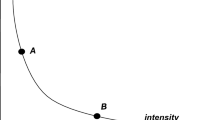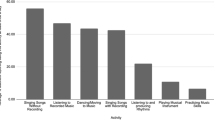Abstract
Does the use of musical accompaniment in instructional media heighten enjoyment, enhance motivation, or increase learning? After tracing music’s role in the development of motion pictures, this article discusses ways instructional message designers can increase the effectiveness of their productions through music. Studies reviewed in this article reveal that musical variables such as tempo, modality, rhythm, and harmony play an important part in determining the affective or emotional response of message receivers. If instructional media producers gain a more thorough understanding of the impact different variables have on audiences, they will be able to select appropriate music to help convey their message. Suggestions are made for future research.
Similar content being viewed by others
References
Bates, F. C., & Horvath, T. Discrimination learning with rhythmic and nonrhythmic background music.Perceptual and Motor Skills, 1971,33, 1123–1126.
Bazelon, I.Knowing the score: Notes on film music. New York: Van Nostrand, 1975.
Berg, C. M.Correcting the visual bias: Assessing the functions of music in film and television. Paper presented at the University Film Association, August 18, 1975. (ERIC Document Reproduction Service No. ED 113 772)
Berg, C. M.An investigation of the motives for and realization of music to accompany the American silent film, 1896–1927. New York: Arno Press, 1976.
Berg, C. M., & Infante, D. A.The impact of music modality in the perception of moving images. Paper presented at the International Communication Association, Portland, Oreg., April 14–17, 1976. (ERIC Document Reproduction Service No. ED 122 335)
Bobker, L. R.Elements of film. New York: Harcourt Brace Jovanovich, 1974.
Bradley, S. Personality on the sound track.Music Educators Journal, 1947,33(3), 28; 30.
Copland, A.Our new music: Leading composers in Europe and America. New York: McGraw-Hill, 1941.
Dreher, R.The relationship between verbal reports and galvanic skin responses to music. Unpublished doctoral dissertation, Indiana University, 1947.
Eisenstein, S. [Film form] (J. Leyda, ed. and trans.). New York: Harcourt, Brace, 1949.
Evans, M.Soundtrack: The music of the movies. New York: Hopkinson and Blake, 1975.
Farnsworth, P. R. A study of the Hevner adjective list.Journal of Aesthetics and Art Criticism, 1954,13, 97–103.
Fleming, M., & Levie, W. H.Instructional message design: Principles from the behavioral sciences. Englewood Cliffs, N.J.: Educational Technology Publications, 1978.
Freeman, J., & Neidt, C. O. Effects of familiar background music upon film learning.Journal of Educational Research, 1959,53, 91–96.
Gallez, D. W. The effect upon cognitive learning of background music in instructional films (Doctoral dissertation, University of California at Berkeley, 1975).Dissertation Abstracts International, 1976,37, 101A. (University Microfilms No. 76-15, 187)
Gerrero, R. H. Music as a film variable (Doctoral dissertation, Michigan State University, 1969).Dissertation Abstracts International, 1969,30, 2555A. (University Microfilms No. 69-20, 859)
Gillis, D.The art of media instruction. Dallas, Tex.: Crescendo, 1973.
Griffin, T. S. An experimental study of the effectiveness of functional music in instructional television (Doctoral dissertation, New York University, 1968).Dissertation Abstracts International, 1969,29, 3169A-3170A. (University Microfilms No. 69-3174)
Herman, L.Educational films: Writing, directing, and producing for classroom, television, and industry. New York: Crown, 1965.
Hevner, K. The affective character of the major and minor mode in music.American Journal of Psychology, 1935,47, 103–108.(a)
Hevner, K. Expression in music: A discussion of experimental studies and theories.Psychological Review, 1935,42, 186–204.(b)
Hevner, K. Experimental studies of the elements of expression in music.American Journal of Psychology, 1936,48, 246–268.
Hevner, K. The affective value of pitch and tempo in music.American Journal of Psychology, 1937,49, 621–630.
Hoban, C. F., & Van Ormer, E. B.Instructional film research 1918–1950. New York: Arno Press &The New York Times, 1970.
Hofmann, C.Sounds for silents. New York: Drama Book Specialists, 1970.
Isenhour, J. P. The effects of context and order in film editing.AV Communication Review, 1975,23, 69–80.
Key, W. B.Media sexploitation. New York: Signet, 1976.
Kohn, H.The twentieth century: A mid-way account of the Western world. New York: Macmillan, 1949.
Kracauer, S.From Caligari to Hitler: A psychological history of the German film. Princeton, N.J.: Princeton University Press, 1947.
Liu, A. Cross-modality set effect on the perception of ambiguous pictures.Bulletin of the Psychonomic Society, 1976,7, 331–333.
Lumsdaine, A. A., & Gladstone, A. Overt practice and audio-visual embellishments. In M. A. May & A. A. Lumsdaine (Eds.),Learning from films. New Haven, Conn.: Yale University Press, 1958.
Mann, R. E. The effect of music and sound effects on the listening comprehension of fourth grade students (Doctoral dissertation, North Texas State University, 1979).Dissertation Abstracts International, 1979,40, 1220A. (University Microfilms No. 7919733)
Manvell, R., & Huntley, J.The technique of film music. New York: Hastings House, 1975.
May, J. L., & Hamilton, P.A.Femaleś evaluations of males as a function of affect arousing musical stimuli. Paper presented at the Midwestern Psychological Association, Chicago, May 5–7, 1977. (ERIC Document Reproduction Service No. ED 143 954)
Merrill, I. R. Attitude films and attitude change.AV Communication Review, 1962,10, 3–13.
Moakley, F. X. The effects on learning from a motion picture film of selective changes in sound track loudness level (Doctoral dissertation, Indiana University, 1968).Dissertation Abstracts International, 1969,29, 1809A. (University Microfilms No. 68-17, 283)
O’Sullivan, K.The psychology of sound (DIST Training Handout No. 5). Bloomington, Ind.: Indiana University School of Education, no date.
Prendergast, R. M.Film music: A neglected art. New York: W. W. Norton, 1977.
Rigg, M. G. Speed as a determiner of musical mood,journal of Experimental Psychology, 1940,27, 566–571.
Rink, O. P. Background music in dramatic television: Will it increase learning for American university students?International Journal of Instructional Media, 1975-1976,3, 193–203.
Rotha, P.Documentary film. New York: Hastings House, 1963.
Saettler, P.A history of instructional technology. New York: McGraw-Hill, 1968.
Schramm, W. What the research says. In W. Schramm (Ed.),Quality in instructional television. Honolulu: The University of Hawaii, 1972.
Schwartz, S. Film music and attitude change: A study to determine the effect of manipulating a musical soundtrack upon changes in attitude toward militarism-pacifism held by tenth grade social studies students (Doctoral dissertation, Syracuse University, 1970).Dissertation Abstracts International, 1971,32, 5677A. (University Microfilms No. 71-10, 977)
Tannenbaum, P. H. Music background in the judgement of stage and television drama.Audio-Visual Communication Review, 1956,4, 92–101.
Thomas, T.Music for the movies. New York: A. S. Barnes, 1973.
Travers, R. M. W. The transmission of information to human receivers.AV Communication Review, 1964,12, 373–385.
Valentino, J. Facing the music: The producer and the production.Video Systems, 1978,4(8), 36; 39; 40.
Valentino, J. Using music in your audio visual productions: How to choose it/when to use it.Audio Visual Product News, 1980,2(9), 94–95.
VanderMeer, A. W. Training film evaluation: Comparison between two films on personal hygiene: TF8-155 and TF8-1665 (Technical Report No. 269-7-50). In C. R. Carpenter & L. P. Greenhill (Eds.),Instructional film research reports (Vol. 2). Port Washington, N.Y.: U.S. Naval Special Devices Center, 1956.
Vinovich, G. S.The communicative significance of musical affect in eliciting differential perception, cognition, and emotion in sound-motion media messages. Unpublished doctoral dissertation, University of Southern California, 1975.
Wagley, M. J. W. The effects of music on affective and cognitive development of soundsymbol recognition among preschool children (Doctoral dissertation, Texas Woman’s University, 1978).Dissertation Abstracts International, 1978,39, 1316A. (University Microfilms No. 7815605)
Wolf, W. Facing the music: Why movie scores are usually so awful. In J. L. Limbacher (Ed.),Film music: From violins to video. Metuchen, N. J.: The Scarecrow Press, 1974.
Zettl, H.Sight sound motion: Applied media aesthetics. Belmont, Calif.: Wadsworth, 1973.
Zuckerman, J. V.Music in motion pictures: Review of literature with implications for instructional films. Philadelphia: Pennsylvania State College, 1949. (ERIC Document Reproduction Service No. ED 002 434)
Author information
Authors and Affiliations
Rights and permissions
About this article
Cite this article
Seidman, S.A. On the contributions of music to media productions. ECTJ 29, 49–61 (1981). https://doi.org/10.1007/BF02765192
Issue Date:
DOI: https://doi.org/10.1007/BF02765192




